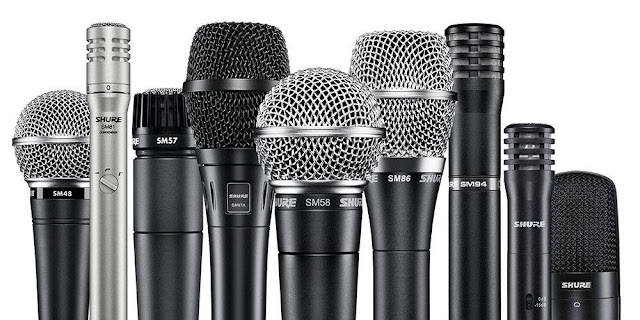Microphones are essential tools in the world of audio, capturing sound waves and transforming them into electrical signals that can be amplified or recorded. Understanding the different types of microphones and their applications is crucial for anyone working in the field of audio production, broadcasting, or live performances.
Learn a detailed
comparison of RE20 vs SM7B microphones to make an informed decision by reading RE20 vs SM7B
microphone comparison article.
Understanding How Microphones Work
Prior to exploring the
diverse categories of microphones, establishing a fundamental comprehension of
their operational principles is crucial. Microphones fundamentally function by
transforming acoustic energy, represented by sound waves, into electrical
signals. This intricate process relies on transducers, components designed to
react to fluctuations in air pressure. Their role is pivotal, as they adeptly
convert these variations into an electrical current. This foundational
knowledge lays the groundwork for understanding how microphones capture and
translate the nuances of sound, underscoring the significance of transducers in
facilitating the conversion of acoustic phenomena into electrical signals for
subsequent amplification or recording purposes.
Types of Microphones
Dynamic Microphones
Dynamic microphones
are rugged and versatile, making them suitable for various applications. They
work by using a diaphragm attached to a coil of wire placed within the magnetic
field of a magnet. As sound waves hit the diaphragm, it moves the coil within
the magnetic field, generating an electrical current.
Condenser Microphones
Condenser microphones
are known for their sensitivity and responsiveness, making them ideal for
capturing a wide range of frequencies. These microphones use a diaphragm placed
close to a backplate. The changing distance between the diaphragm and the
backplate creates variations in electrical capacitance, producing the
electrical signal.
Ribbon Microphones
Ribbon microphones
employ a thin strip of metal (the ribbon) placed between the poles of a magnet.
When sound waves hit the ribbon, it vibrates within the magnetic field,
inducing an electrical current. Ribbon microphones are revered for their warm
and natural sound.
Other Types of Microphones (Carbon and Crystal)
While less common
today, carbon and crystal microphones were once popular. Carbon microphones use
carbon granules that change resistance as they compress, while crystal
microphones use a piezoelectric crystal that generates electrical signals in
response to mechanical pressure.
Subcategories of Microphones
Large-Diaphragm Microphones
Large-diaphragm
microphones are favored for their ability to capture low-frequency sounds with
precision. They are commonly used in studio recording for vocals and
instruments.
Small-Diaphragm Microphones
Small-diaphragm
microphones are prized for their accuracy in reproducing high-frequency sounds.
They are often used for capturing detailed audio in orchestral recordings and acoustic
instruments.
Lavalier Microphones
Lavalier microphones
are small, clip-on microphones commonly used in broadcasting and public
speaking. They offer hands-free operation and discreet placement.
Shotgun Microphones
Shotgun microphones
have a highly directional pickup pattern, making them ideal for capturing sound
from a specific direction. They are commonly used in film and television
production.
Multi-Pattern Microphones
Multi-pattern
microphones allow users to switch between different polar patterns, providing
versatility in capturing various sound sources. They are useful in diverse
recording situations.
Polar Patterns of Microphones
Understanding the
polar patterns of microphones is crucial for achieving optimal sound capture.
Different polar patterns determine the microphone's sensitivity to sounds from
different directions.
Cardioid Microphones
Cardioid microphones
are most sensitive to sounds from the front and least sensitive to sounds from
the rear. They are commonly used for recording a single sound source.
Supercardioid Microphones
Supercardioid
microphones have a narrower pickup pattern than cardioid microphones, making
them more focused on the desired sound source.
Omnidirectional Microphones
Omnidirectional
microphones capture sound equally from all directions, providing a more natural
and spacious sound image. They are suitable for recording ambient sounds or
multiple sound sources.
Figure-8 Microphones
Figure-8 microphones
capture sound from the front and rear while rejecting sounds from the sides.
They are useful for recording two sound sources simultaneously.
Choosing the Right Microphone: Factors to Consider
Choosing the
appropriate microphone requires a thoughtful evaluation of factors such as the
intended purpose, surrounding environmental conditions, and the unique
characteristics of the sound source. Essential considerations encompass
sensitivity, frequency response, and durability, all of which are pivotal in
making a well-informed decision. The sensitivity of a microphone to varying
sound levels, its ability to capture a broad or specific range of frequencies,
and its overall robustness contribute significantly to the selection process.
By carefully weighing these elements, individuals can make informed choices
that align perfectly with their specific recording or performance requirements.
Microphone Applications: Best Microphones for Different Uses
A wide array of
microphones is tailored to diverse applications, ensuring suitability for
recording vocals, instruments, podcasts, or field recordings. Specific
microphones are crafted to meet individual requirements, emphasizing the
importance of comprehending each microphone's unique characteristics. This
understanding becomes pivotal in attaining the desired audio quality for your
recordings. Whether you're a musician, podcaster, or audio engineer, the
availability of various microphone types allows for precise selection,
contributing to optimal results in your chosen audio endeavors. Selecting a
microphone aligned with your specific needs ensures that your recordings and
performances maintain a high standard of audio excellence.
Conclusion
In conclusion, the
world of microphones is vast and varied, offering a plethora of options to suit
different audio recording needs. Whether you're a professional audio engineer,
a content creator, or a musician, understanding the main types of microphones
and their applications empowers you to make informed decisions when selecting
the best microphone for your specific requirements. By considering factors such
as microphone type, polar pattern, and subcategories, you can ensure that your
recordings and performances are of the highest quality.









.jpg)


0 Comments